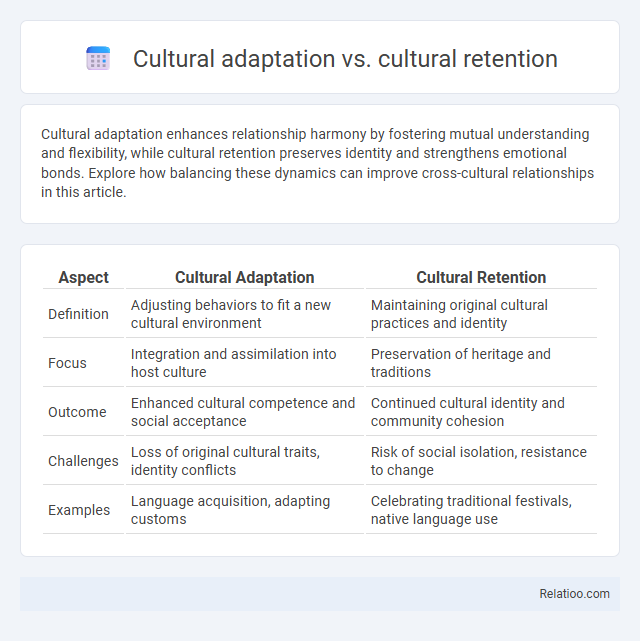Cultural adaptation enhances relationship harmony by fostering mutual understanding and flexibility, while cultural retention preserves identity and strengthens emotional bonds. Explore how balancing these dynamics can improve cross-cultural relationships in this article.
Table of Comparison
| Aspect | Cultural Adaptation | Cultural Retention |
|---|---|---|
| Definition | Adjusting behaviors to fit a new cultural environment | Maintaining original cultural practices and identity |
| Focus | Integration and assimilation into host culture | Preservation of heritage and traditions |
| Outcome | Enhanced cultural competence and social acceptance | Continued cultural identity and community cohesion |
| Challenges | Loss of original cultural traits, identity conflicts | Risk of social isolation, resistance to change |
| Examples | Language acquisition, adapting customs | Celebrating traditional festivals, native language use |
Understanding Cultural Adaptation
Cultural adaptation refers to the dynamic process by which individuals or groups adjust their behaviors, values, and customs to align with a new cultural environment, enhancing social integration and functionality. Unlike cultural retention, which involves preserving original cultural identities and traditions, cultural adaptation emphasizes flexibility and responsiveness to external cultural influences while maintaining a sense of self. Acculturation encompasses both adaptation and retention, representing the broader exchange and assimilation of cultural traits between interacting groups.
The Essence of Cultural Retention
Cultural retention preserves essential traditions, values, and practices that maintain a community's identity despite external influences. This process ensures your cultural heritage remains vibrant and resilient, providing a sense of continuity and belonging across generations. Unlike acculturation or adaptation, cultural retention prioritizes safeguarding core elements that define a group's unique worldview and social fabric.
Key Differences Between Adaptation and Retention
Cultural adaptation involves actively adjusting behaviors and practices to fit a new cultural environment, while cultural retention emphasizes maintaining original cultural traits despite external influences. Your ability to adapt often requires integrating new customs without completely abandoning your cultural identity, whereas retention prioritizes preserving traditions unchanged. Acculturation, by contrast, describes the overall process where both adaptation and retention coexist as cultures interact and influence each other.
Factors Influencing Cultural Adaptation
Factors influencing cultural adaptation include language proficiency, social support networks, and individual openness to new experiences, which play critical roles in how effectively you adjust to a new cultural environment. Socioeconomic status and the degree of cultural distance between your original culture and the host culture also significantly impact the adaptation process. Understanding these factors helps navigate the balance between cultural retention and acculturation, optimizing your integration experience.
Challenges in Maintaining Cultural Retention
Challenges in maintaining cultural retention include navigating the pressure to assimilate into the dominant culture while preserving traditional practices, languages, and values. You often face identity conflicts and intergenerational gaps as younger members may adopt new cultural traits more readily. Balancing adaptation without losing core cultural elements requires intentional effort amid globalization and societal integration pressures.
Role of Identity in Cultural Choices
Cultural adaptation, cultural retention, and acculturation each influence how your identity shapes decisions about cultural participation and preservation. In cultural adaptation, individuals modify behaviors to fit a new cultural environment while maintaining core aspects of their identity, whereas cultural retention emphasizes preserving original cultural traits as a means of reinforcing a stable identity. Acculturation involves blending elements of both cultures, resulting in complex identity negotiations that impact your cultural choices and social integration.
Impact of Globalization on Cultural Practices
Globalization accelerates cultural adaptation by exposing societies to diverse influences, leading to the modification of traditional practices to fit new global contexts. While cultural retention preserves core customs and identities amidst external pressures, acculturation involves the exchange and blending of cultural traits resulting from sustained contact between different cultures. This dynamic interplay reshapes cultural landscapes worldwide, influencing language use, social behaviors, and value systems.
Generational Perspectives on Culture
Generational perspectives on culture highlight distinct approaches between cultural adaptation, cultural retention, and acculturation, where younger generations often embrace cultural adaptation by integrating new societal norms, while older generations prioritize cultural retention to preserve traditional values. Acculturation serves as a dynamic process through which individuals and groups negotiate their cultural identities by balancing heritage culture maintenance with the adoption of elements from the dominant culture. Research underscores that the degree of cultural retention and adaptation varies significantly among generations, influencing identity formation, social integration, and intergenerational communication within multicultural societies.
Balancing Integration and Tradition
Balancing integration and tradition involves navigating cultural adaptation, cultural retention, and acculturation processes, where individuals adjust to a new culture while preserving their original cultural identity. Effective cultural adaptation promotes social cohesion by integrating newcomers into mainstream society without erasing cultural heritage, whereas cultural retention safeguards customs, language, and values integral to ethnic identity. Acculturation frameworks such as Berry's model emphasize the importance of achieving bicultural competence to maintain psychological well-being and community belonging during cultural transitions.
Case Studies: Examples of Adaptation and Retention
Case studies reveal how cultural adaptation involves individuals or groups modifying behaviors to fit a new environment, such as immigrants learning the language and customs of their host country. In contrast, cultural retention is evident when communities consciously preserve traditional practices, like indigenous tribes maintaining rituals despite external influences. Your understanding of acculturation deepens by examining these examples, highlighting the balance between adopting new cultural traits and preserving original identities.

Infographic: Cultural Adaptation vs Cultural Retention
 relatioo.com
relatioo.com